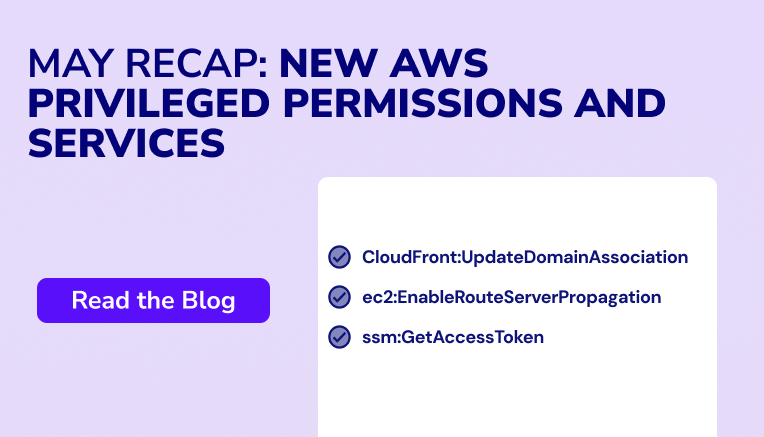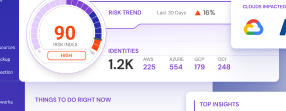Table of Contents

As May 2025 comes to a close, we’re back with the latest roundup of AWS privileged permission updates and service-level developments reshaping cloud security. Tracking these changes is essential, as newly introduced permissions often grant deep access to critical services — opening doors to risks like lateral movement, data exposure, and evasion of security controls. This month, we’ve flagged new privileged permissions across services including CloudFront, EC2, Systems Manager, and AWS Network Firewall. Each one carries potential implications for access governance, network trust boundaries, and operational oversight. Read on for a breakdown of what’s new — and why these permissions matter for hardening your cloud environment.
Existing Services with New Privileged Permissions
Amazon Q Business
Service Type: Artificial Intelligence & Machine Learning
Permission: qbusiness:CreateAnonymousWebExperienceUrl
- Action: Grants permission to create a unique URL for anonymous Amazon Q web experience
- Mitre Tactic: Initial Access
- Why it’s privileged: Allows AI Assistants to analyze internal data from pre-configured data sources, which could potentially grant unauthorized identities access to proprietary data.
Amazon CloudFront
Service Type: Networking and Content Delivery
Permission: cloudfront:UpdateDomainAssociation
- Action: Grants permission to update a domain association
- Mitre Tactic: Defense Evasion
- Why it’s privileged: Allows updates to domain associations, which could enable threat actors to reroute traffic to malicious endpoints or hijack content delivery paths.
Permission: cloudfront:DisassociateDistributionTenantWebACL
- Action: Grants permission to disassociate a distribution tenant from an AWS WAF web ACL
- Mitre Tactic: Defense Evasion
- Why it’s privileged: Allows removal of a Web ACL from a CloudFront distribution in a multi-tenant environment, potentially disabling critical security protections like rate limiting and IP blocking, thereby exposing the distribution to malicious traffic and abuse.
Permission: cloudfront:DisassociateDistributionTenantWebACL
- Action: Grants permission to disassociate a distribution from an AWS WAF web ACL
- Mitre Tactic: Defense Evasion
- Why it’s privileged: Allows removal of a Web ACL from a CloudFront distribution, potentially stripping away key security controls such as WAF rules, leaving the distribution vulnerable to threats like SQL injection, XSS, and bot attacks
Amazon EC2
Service Type: Compute Services
Permission: ec2:CreateLocalGatewayVirtualInterface
- Action: Grants permission to create a local gateway virtual interface
- Mitre Tactic: Persistence
- Why it’s privileged: Allows the association of a LAG (Link Aggregation Group) – representing a network connection to an external device – with a VLAN in the outpost. This enables establishing direct connectivity with external networks
Permission: ec2:EnableRouteServerPropagation
- Action: Grants permission to enable route server propagation
- Mitre Tactic: Persistence
- Why it’s privileged: Allows propagation of routes from a virtual private gateway to a VPC route table, which could be exploited to alter network traffic flow and inadvertently expose internal AWS resources to on-premises or external networks, increasing the risk of unauthorized access or data leakage.
Permission: ec2:CreateRouteServerPeer
- Action: Grants permission to create a route server peer
- Mitre Tactic: Defense Evasion
- Why it’s privileged: Allows creation of BGP sessions with internal devices like firewalls, which could redirect traffic through weaker or unmonitored paths, potentially bypassing key security controls and exposing the environment to lateral movement or data exfiltration.
AWS Systems Manager
Service Type: Infrastructure Management
Permission: ssm:GetAccessToken
- Action: Grants permission to return a credentials set to be used with just-in-time node access
- Mitre Tactic: Credential Access
- Why it’s privileged: Allows retrieval of access tokens, which could enable unauthorized users to authenticate and perform privileged actions such as executing commands on managed instances or accessing privileged systems management data.
Permission: ssm-guiconnect:UpdateConnectionRecordingPreferences
- Action: Grants permission to update GUI Connect connection recording preferences
- Mitre Tactic: Reconnaissance
- Why it’s privileged: Allows modification of session recording settings, which could be exploited to disable auditing and monitoring of user activity, obscuring malicious behavior and hindering forensic investigations.
AWS Network Firewall
Service Type: Security Services
Permission: network-firewall:DeleteVpcEndpointAssociation
- Action: Grants permission to delete a vpc endpoint association
- Mitre Tactic: Impact
- Why it’s privileged: Allows removal of a VPC endpoint’s association with a Network Firewall, which could disable critical traffic inspection and expose services to unfiltered access, increasing the risk of malicious activity going undetected.
New Services with New Privileged Permissions
AWS Transform
Service Type: Migration and Transfer
Permission: transform:AssociateConnectorResource
- Action: Grants permission to invoke AssociateConnectorResource on AWS Transform
- Mitre Tactic: Collection
- Why it’s privileged: Grants a (potentially cross-account) transform profile access to an S3 bucket. The contents of that S3 bucket can then be examined by transform-enabled users in the transform profile’s account.
AWS Service for managing account level display settings
Service Type: Support and Service Management
No privileged permissions
Conclusion
As AWS continues to evolve, the scope and power of newly introduced permissions demand greater scrutiny. This month’s updates underscore how privileged permissions — from configuring BGP peers in EC2 to disabling critical inspection layers in CloudFront and Network Firewall — can quietly introduce opportunities for lateral movement, data exfiltration, or security control evasion if left unchecked.
Sonrai Security helps teams stay ahead of these risks with our Cloud Permissions Firewall — a modern approach to Privileged Access Management purpose-built for the cloud. By continuously detecting and restricting overly permissive access, and enforcing least privilege at scale, we enable security, IAM, and cloud teams to control privilege sprawl, reduce risk, and adapt securely as AWS services expand.



